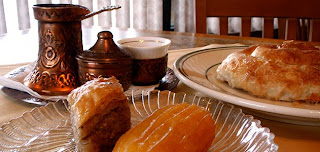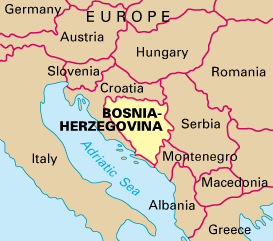Bosnia and Herzegovina
(Bosna i Hercegovina). State of the Balkan Peninsula (51,209 km ²). Capital: Sarajevo. Administrative division: Muslim-Croat Federation (FCM), divided into 10 cantons, and the Republic of Serbia, consisting of 7 regions. Population: 4,377,033 inhabitants. (estimate 2009). Language:
Bosnian language, Serbian and Croatian (official). Religion: Sunni Muslim (43%), Orthodox (29.9%), Catholics (18%), other (9.1%). Currency: Convertible Mark (tied to a fixed exchange rate to the euro). Human Development Index: 0.812 (76th place). Borders: Serbia (E) and Croatia (NW-S). Member of: CEFTA, EBRD, UN and OSCE, EU associated.
Generality
The territory of Bosnia and Herzegovina, in the heart of the Western Balkans, including Bosnia N itself, crossed by a number of tributaries of the Sava and therefore belonging to the Danube basin, the S and Herzegovina, including in the Mediterranean watershed. Both regions are predominantly mountainous, even if the first, more rich in water, is largely covered with woods, while the latter appears more arid. The country derives its name from two historical regions that compose it: Bosnia after the river that runs through most of the territory, Herzegovina from herceg (in Serbian "Duke"), having had a period of autonomy as a duchy in sec . XV. Bosnia and Herzegovina has been characterized over the centuries to the ethnic homogeneity of the population, of Slavic origin and united by the same language, as opposed to a religious differentiation, given the coexistence of Islam, Orthodox Christianity, and Catholicism - to the forties of the century . XX - Judaism. In an independent Bosnia in the Middle Ages followed the centuries-old Ottoman-turkish domination lasted from sec. XV in 1878, the Habsburg for forty years until 1918, the region's integration into the Serbian monarchy in Belgrade, then in the Croatian Ustasha State during the Second World War, and then in Yugoslavia from 1945 to 1992, the proclamation of independence. That same year, in conjunction with the international recognition of Bosnia and Herzegovina as a sovereign state, among other national and religious components of the country is a war in which they participated indirectly neighboring countries and featured speeches UN, NATO and then the action of the United States which required the cessation of hostilities in 1995. This was followed by a peace settlement in which, leaving unchanged the external borders of the country, took place an institutional reconfiguration of the state and a new partition of the territory between the warring entities. Already at the time of Yugoslavia, Bosnia and Herzegovina was one of the most economically backward republics. Subsequently, the transition from a planned to a free market, the destruction of the war years of 1992-1995 and the poor function of the spatial organization of the postwar period, prevented - despite international aid - the economic recovery of the country, which is among the poorest in Europe. In fact, the production activities, which collapsed during the conflict, not recovered to some extent in the next decade due to both the absence of the system in which Bosnia supplemented its economy with the other republics of the Yugoslav federation, is also protective barriers that impede the free Bosnian movement of goods within the EU. The consequences of this situation are very low per capita incomes, high unemployment, development of a "black" for the most part controlled by organized crime, as well as a propensity to emigrate abroad in search of better living conditions. The components of Croatian and Serbian population feel respectively Croatia and Serbia as their true home countries, thus establishing preferential relations with these countries, all the people, regardless of national identity, aims at integration of Bosnia and Herzegovina the EU, although in 2005 there were still negotiations for his association, a preliminary step to a full membership.
The State
Already Union Republic within the Yugoslav Federation, declared its independence in 1992, an act that is at the root of the conflict between the three ethnic groups in the area to the control of the State, which degenerated into one of the bloodiest wars occurring in the European territory in sec. XX. With the Dayton Agreement (1995), the country has enshrined its integrity in a new and original form of political-territorial units: single state divided into two entities, each with its own parliament and government, one Muslim-Croat (Muslim-Croat Federation, 51% of the territory), the other Serb (Republika Srpska, 48% approx. territory), in addition to the Brčko District in northeastern Bosnia, formerly assigned to the Republic of Serbia and became independent in 1999 following international arbitration. The Muslim-Croat Federation is led by a president and a vice alternately Croatian and Muslim, and the legislative power lies with Parliament, composed of the House of Representatives (140 members) and the Chamber popular (74 members). The Republic of Serbia is led by a president and vice-president and the National Assembly consists of 140 members. The central presidency of the republic consists of three members, elected by universal suffrage for two years, representing the three ethnic groups (a Muslim, a Serb, a Croat) presides over first, the one who received the majority of votes, then rotates every eight months. The central Parliament consists of two chambers: the House of Representatives (42 members elected by direct popular vote, two-thirds Muslim-Croat and Serb third), based in Sarajevo, and the House of Representatives (5 delegates for each ethnic group ), which meets in Lukavica. The central executive is made up of a Council of Ministers appointed by the president; under his guidance there are two co-prime ministers (Muslim and Serbian), supported by a Deputy Prime Minister (Croatian). In December 1997, following pressure from the International Council for the respect of the Dayton Agreement, representatives of the three ethnic groups have signed an agreement on joint Bosnian passport, citizenship and functioning of the Council of Ministers. The territory of the Federation is divided into ten cantons, each with its own constitution and administrative organization, in turn divided into a total of 85 municipalities: Unsko-Sanski (1), Tuzlanski (3), Zeničko-Dobojski (4), Bosansko-Podrinjski ( 5) and Sarajevo (9) that are Bosniaks, Posavski (2), Zapadno-Hercegovački (8) and Herceg-Bosanski (10) Croats, Srednjobosanski (6) and Hercegovačko-Neretvanski (7) that are mixed Bosniak and Croat. The Republic of Serbia consists of 7 regions, subdivided into 64 municipalities: Banja Luka, Doboj, Bijeljina, Vlasenica, Sokolac, Srbinje (ex Foča), Trebinje. The judicial system, in the process of adaptation to European standards, is not yet definitively structured. The only armed force, this is the army, organized independently by each of the two entities. Bosnia and Herzegovina, at first under the military control of NATO, from December 2, 2004 is guarded by contingents of the EU (EUFOR - European Stabilisation Force) and a High Representative of the international community. Compulsory schooling lasts 11 years, divided in primary education (8 years) and medium. The rate of illiteracy, in 2008 was 2.4%.







